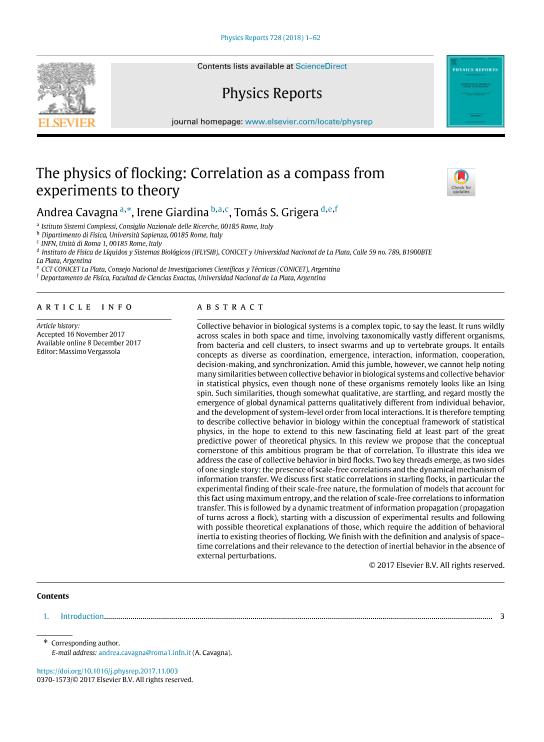Artículo
The physics of flocking: Correlation as a compass from experiments to theory
Fecha de publicación:
01/2018
Editorial:
Elsevier Science
Revista:
Physics Reports-review Section Of Physics Letters
ISSN:
0370-1573
Idioma:
Inglés
Tipo de recurso:
Artículo publicado
Clasificación temática:
Resumen
Collective behavior in biological systems is a complex topic, to say the least. It runs wildly across scales in both space and time, involving taxonomically vastly different organisms, from bacteria and cell clusters, to insect swarms and up to vertebrate groups. It entails concepts as diverse as coordination, emergence, interaction, information, cooperation, decision-making, and synchronization. Amid this jumble, however, we cannot help noting many similarities between collective behavior in biological systems and collective behavior in statistical physics, even though none of these organisms remotely looks like an Ising spin. Such similarities, though somewhat qualitative, are startling, and regard mostly the emergence of global dynamical patterns qualitatively different from individual behavior, and the development of system-level order from local interactions. It is therefore tempting to describe collective behavior in biology within the conceptual framework of statistical physics, in the hope to extend to this new fascinating field at least part of the great predictive power of theoretical physics. In this review we propose that the conceptual cornerstone of this ambitious program be that of correlation. To illustrate this idea we address the case of collective behavior in bird flocks. Two key threads emerge, as two sides of one single story: the presence of scale-free correlations and the dynamical mechanism of information transfer. We discuss first static correlations in starling flocks, in particular the experimental finding of their scale-free nature, the formulation of models that account for this fact using maximum entropy, and the relation of scale-free correlations to information transfer. This is followed by a dynamic treatment of information propagation (propagation of turns across a flock), starting with a discussion of experimental results and following with possible theoretical explanations of those, which require the addition of behavioral inertia to existing theories of flocking. We finish with the definition and analysis of space-time correlations and their relevance to the detection of inertial behavior in the absence of external perturbations.
Palabras clave:
Flocking
,
Correlations
,
Collective motion
Archivos asociados
Licencia
Identificadores
Colecciones
Articulos(IFLYSIB)
Articulos de INST.FISICA DE LIQUIDOS Y SIST.BIOLOGICOS (I)
Articulos de INST.FISICA DE LIQUIDOS Y SIST.BIOLOGICOS (I)
Citación
Cavagna, Andrea; Giardina, Irene; Grigera, Tomas Sebastian; The physics of flocking: Correlation as a compass from experiments to theory; Elsevier Science; Physics Reports-review Section Of Physics Letters; 728; 1-2018; 1-625
Compartir
Altmétricas




